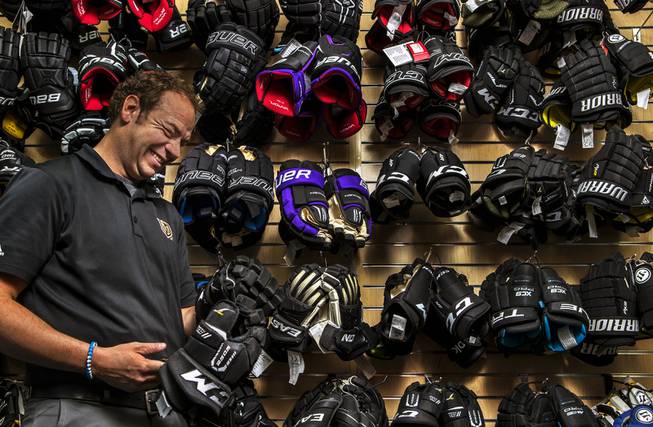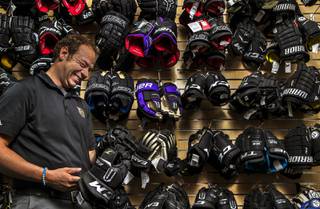
Chris Davidson-Adams, the head equipment manager for the Vegas Golden Knights, is shown in the pro shop at the Las Vegas Ice Center on Friday, May 19, 2017.
Saturday, May 27, 2017 | 2 a.m.
Hockey 101
On an average day NHL equipment manager Chris Davidson-Adams gets to the rink at 6 a.m. and won’t leave until 6 p.m. On game days, he arrives an hour earlier and sometimes doesn’t get home until midnight.
Davidson-Adams sharpens every skate and maintains every hockey stick, helmet and pad you see on the ice.
He has worked more than 1,000 games over 21 seasons, including stints with the Dallas Stars and San Jose Sharks, and now manages the purchasing of all player equipment for the expansion Vegas Golden Knights.
He’s eager to continue his labor of love with the new franchise.
“Our spouses are the most important people in this line of work,” Davidson-Adams said. “My wife (Kelly) is the most understanding person in the world. I think it was actually voted on and she won.”
Of all the equipment he deals with, it’s hockey sticks that are arguably the most important. Players are always coming to Davidson-Adams for small tweaks and customizations to their sticks, fine-tuning them for maximum performance.
An average NHL hockey stick costs $185, and players go through 60 to 125 sticks a year, he said. That’s as much as $23,125 in hockey sticks for one player.
“You used to have a piece of wood that would have to react the way players wanted it to, but now the stick is made of carbon fiber and graphite,” Davidson-Adams said. “They react exactly how the players need them to because they’re so customizable whether it be the curve, the flex in the shaft, the kick point or so many other things that engineers have worked on to perfect the hockey stick and make it perform like a racecar.”
Skates, which cost $700 per pair, are equally customizable.
“Your skates and your stick are the most important part of your equipment,” Davidson-Adams said. “These guys have to have full control because this is what wins championships — skates and sticks. If you can’t skate and you can’t shoot, you can’t do much.”
He sharpens every player’s skates each game day. Some prefer them sharpened before morning skate, some after. The boot part of the skate has come a long way since players carved up the ice in leather boots with blades.
“More and more coaches are demanding that players block shots and the last thing that I want as an equipment manager is for a player to feel uncomfortable doing those things,” Davidson-Adams said. “We want these players to go out there and put their body on the line and not feel like they’re going to get hurt.”
All of the pads on an NHL player add up to about $1,200, and with replacements it costs a team about $21,000 per year to outfit a skater. Goalies are even pricier, with teams paying $36,000 per season to keep them suited up.
Still, the equipment isn’t foolproof and injuries still happen. It’s Davidson-Adams’ job to make sure those instances are as rare as possible.
“Just like anything, accidents do happen and pucks find their way into spaces where there’s no padding,” Davidson-Adams said. “You can only protect a person so much before you wrap them in all bubble wrap.”


Join the Discussion:
Check this out for a full explanation of our conversion to the LiveFyre commenting system and instructions on how to sign up for an account.
Full comments policy